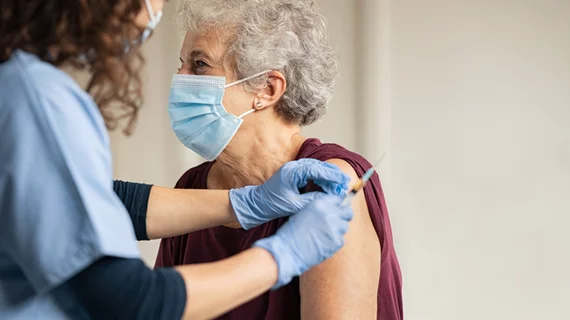Most routine imaging should be scheduled 6 weeks after 2nd vaccine dose, major cancer centers say
Most routine imaging exams, including screenings, should be scheduled either before a patient’s second dose of the COVID-19 vaccine or six weeks afterward, three major cancer centers urged Wednesday.
However, providers should not delay other clinically indicated imaging—i.e., for acute symptoms, short-interval monitoring, or urgent treatment planning—because of a patient’s vaccine history. The recommendations are part of new guidelines from a panel of experts at Memorial Sloan Kettering, MD Anderson and the Dana-Farber Cancer Institute, published in Radiology.
Radiologists in recent weeks have grappled with vaccination-associated adenopathy, leading to a “diagnostic conundrum” where lymph node inflammation may resemble malignancies. Experts believe ongoing conversations are crucial in these cases and encouraged practices to gather details prior to intake.
“Vaccination information—date(s) administered, injection site(s), laterality, and type of vaccine—should be included in every pre-imaging patient questionnaire, and this information should be made readily available to interpreting radiologists,” first author Anton Becker, MD, PhD, with MSK Cancer Center’s Department of Radiology, and co-authors wrote Feb. 24. “Clear and effective communication between patients, radiologists, referring physician teams and the general public should be considered of the highest priority when managing adenopathy in the setting of COVID-19 vaccination.”
A multidisciplinary team of more than a dozen experts across the three “leading” tertiary care cancer centers developed the recommendations. Their hope is to help radiologists and other medical professionals navigate this issue in the absence of any studies or evidence-based guidelines.
In addition, Becker et al. recommended that providers administer vaccine on the side opposite of the primary or suspected cancer, with both doses going into the same arm. They also advocated for postponing routine imaging until at least six weeks after the dose, where possible. And physicians should consider imaging follow-up with ultrasound to ensure that the findings have resolved among certain high-risk patients.
The authors believe addressing this issue will remain a moving target as new strains of the virus continue to emerge.
“This cycle may well continue into the near future. Hence, COVID-19-vaccination-related phenomena such as onset, duration and size limits of associated adenopathy deserve further scientific investigation to inform future clinical guidelines,” they concluded.
You can explore more of their guidance in Radiology here, and read about a second piece on this topic published in RSNA’s flagship publication here.

